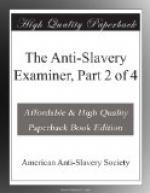The benediction was pronounced, and the assembly retired.
There was an aged negro man present, who was noticed with marked attention by the Archdeacon, the Rector and other clergymen. He is sometimes called the African Bishop. He was evidently used to familiarity with the clergy, and laid his hand on their shoulders as he spoke to them. The old patriarch was highly delighted with the scene. He said, when he was young he “never saw nothing, but sin and Satan. Now I just begin to live.”
On the same occasion the Governor remarked to us that the first thing to be done in our country, toward the removal of slavery, was to discard the absurd notion that color made any difference, intellectually or morally, among men. “All distinctions,” said he, “founded in color, must be abolished everywhere. We should learn to talk of men not as colored men, but as MEN as fellow citizens and fellow subjects.” His Excellency certainly showed on this occasion a disposition to put in practice his doctrine. He spoke affectionately to the children, and conversed freely with the adults.
VISIT TO GREEN CASTLE.
According to a previous engagement, a member of the assembly called and took us in his carriage to Green Castle estate.
Green Castle lies about three miles south-east from St. John’s, and contains 940 acres. The mansion stands on a rocky cliff; overlooking the estate, and commanding a wide view of the island. In one direction spreads a valley, interspersed with fields of sugar-cane and provisions. In another stretches a range of hills, with their sides clad in culture, and their tops covered with clouds. At the base of the rock are the sugar Houses. On a neighboring upland lies the negro village, in the rear of which are the provision grounds. Samuel Bernard, Esq., the manager, received us kindly. He said, he had been on the island forty-four years, most of the time engaged in the management of estates. He is now the manager of two estates, and the attorney for six, and has lately purchased an estate himself. Mr. B. is now an aged man, grown old in the practice of slave holding. He has survived the wreck of slavery, and now stripped of a tyrant’s power, he still lives among the people, who were lately his slaves, and manages an estate which was once his empire. The testimony of such a man is invaluable. Hear him.
1. Mr. B. said, that the negroes throughout the island were very peaceable when they received their freedom.
2. He said he had found no difficulty in getting his people to work after they had received their freedom. Some estates had suffered for a short time; there was a pretty general fluctuation for a month or two, the people leaving one estate and going to another. But this, said Mr. B., was chargeable to the folly of the planters, who overbid each other in order to secure the best hands and enough of them. The negroes had a strong attachment to their homes, and they would rarely abandon them unless harshly treated.




